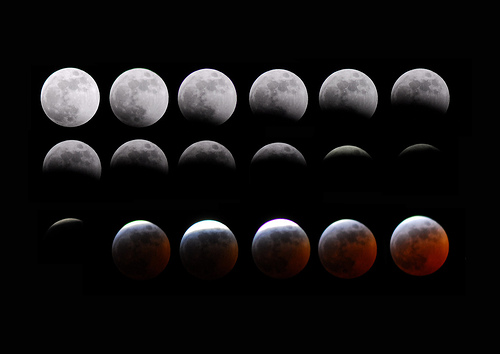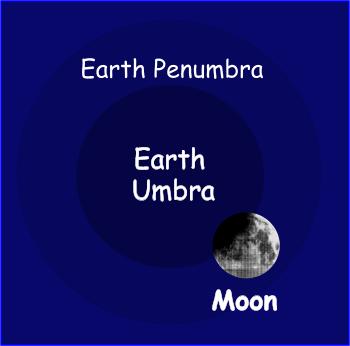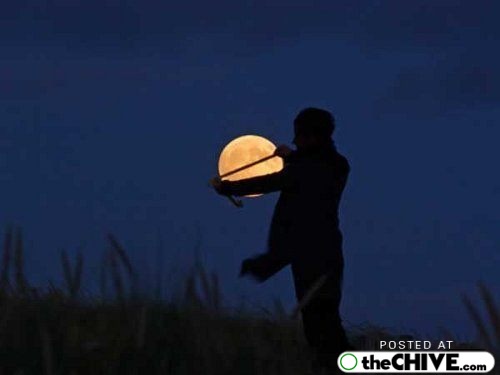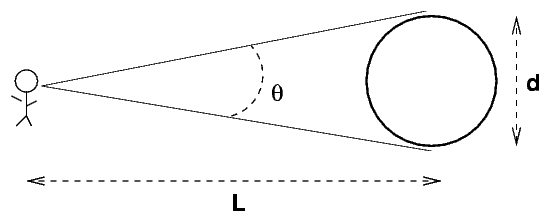"The moon's an arrant thief,
And her pale fire she snatches from the sun." -William Shakespeare
Let's assume you lived before we walked on the Moon. Before we had ever been to space, hell, even before the invention of the telescope. Why not go all the way back to before we knew the planets went around the Sun! You know, back when all you had to go on for knowledge of the sky was your eye.

Some nights, you look up at the sky, and what would you see? Instead of thousands and thousands of stars, something might be filling your sky with light pollution. Indeed, the closest astronomical body to Earth is the brightest thing in our night sky. Say hello to the Moon, which gets its brilliant light by reflecting it from the Sun.

And let's say you wanted to know, looking up at that brilliant orb in the night sky, how big it was and how far away it was. While today we bounce lasers off of a mirror the Apollo astronauts left on the Moon to figure out its distance, there's a neat trick anyone can use to understand the size and distance to the Moon.
First the size. All you need to know to get this is the size of the Earth, which we've known since the 3rd Century B.C. to be about 40,000 km in circumference (or about 13,000 km in diameter). Well, that, and the fact that the Sun is farther away than the Moon is. Which is easy; after all, you've heard about these:

Solar eclipses! Since the Moon can pass in front of the Sun, that tells us the Sun must be farther away! So we can make an approximation (that, to be fair, is only really good if the Sun is a lot farther away than the Moon is) that when we see the Earth's shadow on the Moon, it's about the size of Earth.
And do we ever see the Earth's shadow on the Moon?

That's just what a lunar eclipse is! In fact, we can stitch together a bunch of images from a partial lunar eclipse, and showcase something spectacular:

Wow! So all you need to figure out the diameter of the Moon is to know the diameter of Earth, and measure what the ratio of Earth's shadow is to the size of the Moon! If you guess that the Earth is three times bigger, you're a little low, but if you guess it's four times bigger, you're a little high. It turns out that three-and-two-thirds is just about right, and if I divide that circumference of 40,000 km by three-and-two-thirds, I get 10,900 km for the circumference of the Moon, or (dividing by pi) 3470 km in diameter.
And if I check wikipedia, it tells me the circumference of the Moon is 10,921 km. Yes, just like that, you can figure out the size of the Moon!
But let's say you wanted to go farther, and figure out the distance to the Moon. You could do this, too! Take a look at the Moon in the sky:

As long as you know that there are 360 degrees in a circle, you can figure out how many degrees on the sky the Moon takes up! It turns out it's very close to half-a-degree, which varies depending on whether the Moon is at its closest point to Earth (perigee) or its farthest (apogee).

But if we take the crude "half-a-degree" estimate, we can easily figure out how distant it is to the Moon just by remembering a little trigonometry!

There's a relationship between the size of the angle (θ), the distance to the Moon (L), and the diameter of the Moon (d), just given by the formula:
which gives me a distance to the Moon of just under 400,000 km. This stacks up really well to the modern (average) value of 384,403 km, but it gets even better when you realize the Moon's distance varies between 363,104 km and 406,696 km.
And that's it! Just by using your eyes and your noodle, you too can figure out how big the Moon is and how far away it is from us! Have a great weekend!


Ethan.
Thanks for this. I remember another method for measuring the size knowing distance - or distance knowing size: measure the distance from your eye to a penny when it just covers the moons disk. The do the rig as you show.
Triggers another couple of questions though:
1. Why does the moon pass between the Earth and the Sun (it soesn't have to does it)?
2. Why does the moon's disc almost exatly match that of the Sun at an eclipse? (So we can see just the corona at a total eclipse.)
Pete
@1: 1: Dumb luck. It could easily have an orbit perpendicular to the plane of the Earth orbit (Neptune, for instance, has this, more or less).
2: Dumb luck. The distance between Earth and Moon has varied over the eons, steadily increasing, and right now, we are at the point where the Moon more or less (depending on where in the year/month we are) covers the sun exactly.
That stitched-together photo from the lunar eclipse is really quite striking. I love it.
As for Pete's questions, my take on the answers is:
1. Like most non-captured satellites, our moon orbits in our orbital plane, and so naturally it will intersect the sun's orbital plane.
2. That's an accident of timing. The moon is receding from the earth rather rapidly (for a moon, anyway), and of course it already doesn't match the sun when it's at apogee. Eventually there'll be a time when the corona is never visible at eclipse.
Please explane the formation of stars that look like a crown and has what looks like a thirdeye there was also two triangles pointing in differiant directions and a cross on the left of this formation the triangles where alittle to the right of the crown it was awsome looking .....Pamela
Pamela: in the Buttes Monument picture? That's Orion, one of the few constellations that can be seen from both the northern and southern hemispheres, and one of the most striking.
Didn't ancient Greeks and Indians actually do these calculations? An interesting part of the whole âWe knew more back then than you would think!â
It amazes me how much you can figure out and learn without all the nice modern equipment we have. It's still nice to have that modern equipment, however.
@James
I know the ancient Greeks calculated out the distances of the Moon and Sun, with the Moon being calculated pretty accurately (actually, though, the information I've found showed that the first man to calculate out the distances worked in relative terms, not having an accurate estimate of the Earth's size, even though such an estimate was already available - I guess he didn't have access to it). The Sun's distance and relative size he was far further off on, but even then he was able to realize that the Sun was much larger than the Earth, using it as an argument for heliocentrism.
Wouldn't surprise me if Indian astronomers had made the same calculation. They had a very sophisticated astronomy.
@Pete:
I once came across a book that made the rather bizarre claim that the coincidence of apparent size between the Sun and Moon was proof that the Moon was artificial, built by some ancient alien race. I kind of wish I'd bought that book, actually. Probably would've been good for a few laughs.
It all seems so easy.
I can't imagine why people before the age of the telescope didn't load their digital photos into Photoshop and do the same calculations.
You don't need digital photos to make those calculations! That's merely a demonstration to make it that much clearer. Simply observing the shape of the Earth's shadow on the moon, and sketching it out, allows one to calculate the relative sizes. And, indeed, the astronomer Aristarchus of Samos did just that. http://en.wikipedia.org/wiki/Aristarchus_On_the_Sizes_and_Distances
ever since i was a little girl ive always wanted to be an astornout and no im writing lots of things about space ive studdied on lots of books and what ever thier is about space i would read it no matter how boring some people may think it is ill read it all of it
@Pete
The Moon doesn't pass directly between the Sun and Earth on every orbit, if it did we'd have a solar eclipse every new moon (always in the tropics) and a lunar eclipse every full moon. As the Moon's orbit around the earth is at an angle of about 5 degrees from the plane of the Earth's orbit around the Sun, eclipses only happen when the new moon coincides with the Moon being close enough to the Earth-Sun plane that its shadow falls on the Earth.
If the Moon's orbit were perpendicular to the Earth's orbital plane it would still pass directly between Earth and Sun as Earth orbits around the Sun, and we would have an eclipse exactly twice a year (on the same days each year).
Christina says: I once came across a book that made the rather bizarre claim that the coincidence of apparent size between the Sun and Moon was proof that the Moon was artificial, built by some ancient alien race. I kind of wish I'd bought that book, actually. Probably would've been good for a few laughs. I say: hahah! I totally read that book. It cracked me up. http://en.wikipedia.org/wiki/Aristarchus_On_the_Sizes_and_Distanceshrms This is a great link. I used it with my 12 yr old to help her through some concepts.
como e a lua
??
Didn't ancient Greeks and Indians actually do these calculations? An interesting part of the whole âWe knew more back then than you would think!â
It amazes me how much you can figure out and learn without all the nice modern equipment we have. It's still nice to have that modern equipment, however. driving instructor training
I once read this egyptian jew reached the same results with pretty much the same calculations (must have got something wrong twice somewhere...)
He was a Kabalah expert, and lived 100 Ad.
And I still can't figure out my check at a restaurant.
Robinson
The Sun's distance and relative size he was far further off on, but even then he was able to realize that the Sun was much larger than the Earth, using it as an argument for heliocentrism.
Wouldn't surprise me if Indian astronomers had made the same calculation. They had a very sophisticated astronomy.
Jimmy from http://www.betterinsurancequote.com
Interessting thoughts on moon. I still remember being in the astronomy school, where we were talking about the size of the moon and the all the different things that come into play in Astronomy. Thanks for the information, Jessica from marken lampen in Germany
That means the very table you sat at for breakfast or the hotel bed you fell asleep in. Probably scenic views from your plane seat. Or anything.
Why not build hotels in space? That way the tourists can travel to the space hotel in a standard rocket (where they can experience the thrill of high g-forces). Thenonce they get to the space hotel, wait a few hours or days experiencing weightlessness, then take a shuttle to the Moon, using the Earth's gravity as a slingshot effect to reduce fuel costs, then voila, the moon! On the return trip back to the space hotel, they can use the Moon's gravity in a similar slingshot effect to get back to Earth. Of course, only the filthy rich tourists will help pay for the luxury of going to the Moon, while the rest of us cretins will grumble and complain, at least in the beginning. Someday going to the Moon will be comparitively expensive as having a car, or a personal computer. Does anyone remember how expensive they were when they first came out???? :D
That's a very interesting and intriguing question. From our perspective we would assume its not all that large, but of course this isn't the case. Thanks!
The Sun's distance and relative size he was far further off on, but even then he was able to realize that the Sun was much larger than the Earth, using it as an argument for heliocentrism.
Wouldn't surprise me if Indian astronomers had made the same calculation. They had a very sophisticated astronomy.
thanks for this post
i'm very interested in knowing the nature of moon and it's phtsical composition of matter.i need to know can there exist life on moon in future?